YAMAHA WR 250F 2010 Owners Manual
Manufacturer: YAMAHA, Model Year: 2010, Model line: WR 250F, Model: YAMAHA WR 250F 2010Pages: 232, PDF Size: 13.94 MB
Page 121 of 232
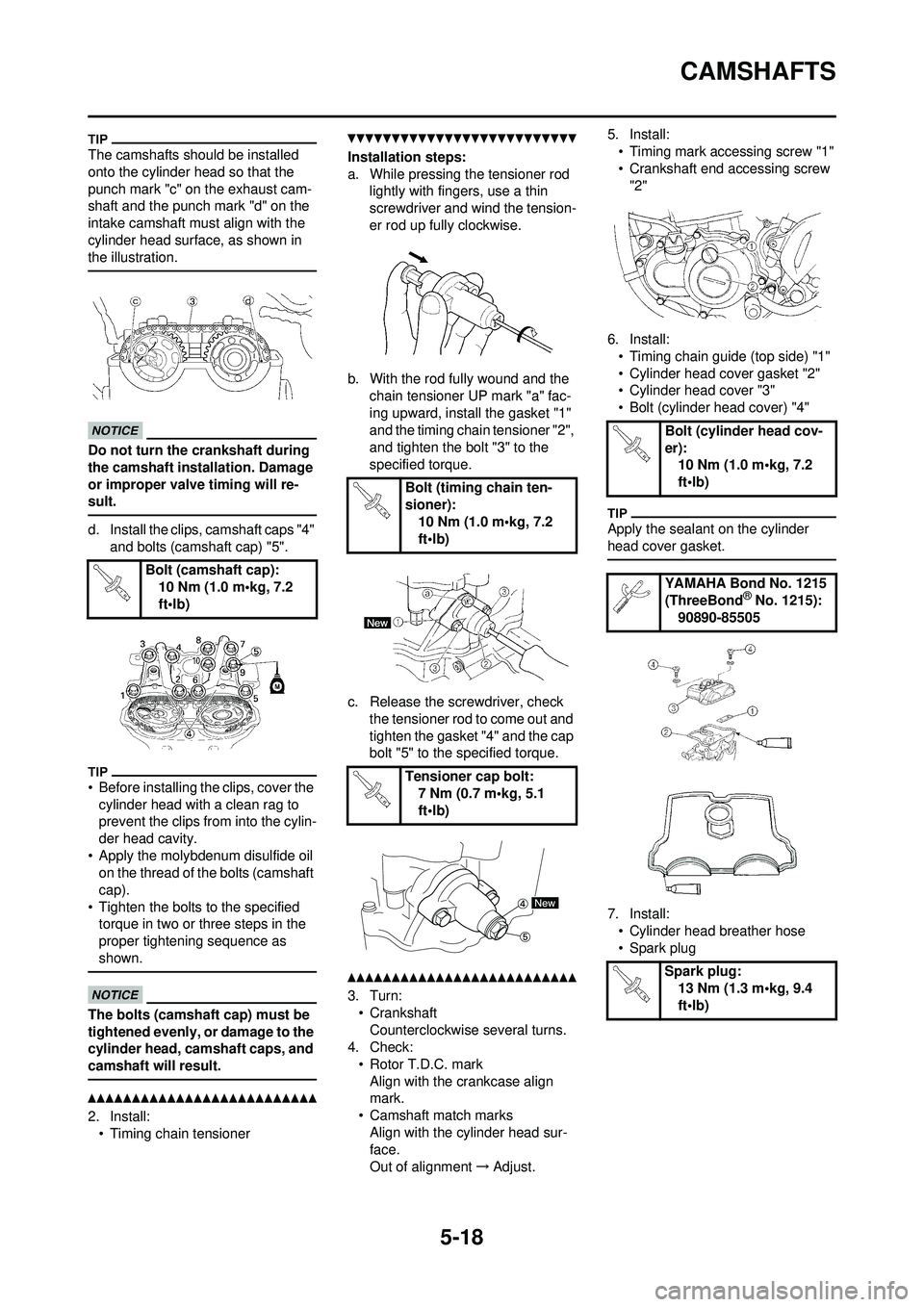
5-18
CAMSHAFTS
The camshafts should be installed
onto the cylinder head so that the
punch mark "c" on the exhaust cam-
shaft and the punch mark "d" on the
intake camshaft must align with the
cylinder head surface, as shown in
the illustration.
Do not turn the crankshaft during
the camshaft installation. Damage
or improper valve timing will re-
sult.
d. Install the clips, camshaft caps "4"
and bolts (camshaft cap) "5".
• Before installing the clips, cover the cylinder head with a clean rag to
prevent the clips from into the cylin-
der head cavity.
• Apply the molybdenum disulfide oil on the thread of the bolts (camshaft
cap).
• Tighten the bolts to the specified torque in two or three steps in the
proper tightening sequence as
shown.
The bolts (camshaft cap) must be
tightened evenly, or damage to the
cylinder head, camshaft caps, and
camshaft will result.
2. Install:• Timing chain tensioner
Installation steps:
a. While pressing the tensioner rod lightly with fingers, use a thin
screwdriver and wind the tension-
er rod up fully clockwise.
b. With the rod fully wound and the chain tensioner UP mark "a" fac-
ing upward, install the gasket "1"
and the timing chain tensioner "2",
and tighten the bolt "3" to the
specified torque.
c. Release the screwdriver, check the tensioner rod to come out and
tighten the gasket "4" and the cap
bolt "5" to the specified torque.
3. Turn:
• CrankshaftCounterclockwise several turns.
4. Check:
• Rotor T.D.C. markAlign with the crankcase align
mark.
• Camshaft match marks Align with the cylinder head sur-
face.
Out of alignment →Adjust. 5. Install:
• Timing mark accessing screw "1"
• Crankshaft end accessing screw "2"
6. Install: • Timing chain guide (top side) "1"
• Cylinder head cover gasket "2"
• Cylinder head cover "3"
• Bolt (cylinder head cover) "4"
Apply the sealant on the cylinder
head cover gasket.
7. Install:• Cylinder head breather hose
• Spark plug
Bolt (camshaft cap):
10 Nm (1.0 m•kg, 7.2
ft•lb)
Bolt (timing chain ten-
sioner):10 Nm (1.0 m•kg, 7.2
ft•lb)
Tensioner cap bolt: 7 Nm (0.7 m•kg, 5.1
ft•lb)
Bolt (cylinder head cov-
er): 10 Nm (1.0 m•kg, 7.2
ft•lb)
YAMAHA Bond No. 1215
(ThreeBond
® No. 1215):
90890-85505
Spark plug: 13 Nm (1.3 m•kg, 9.4
ft•lb)
Page 122 of 232
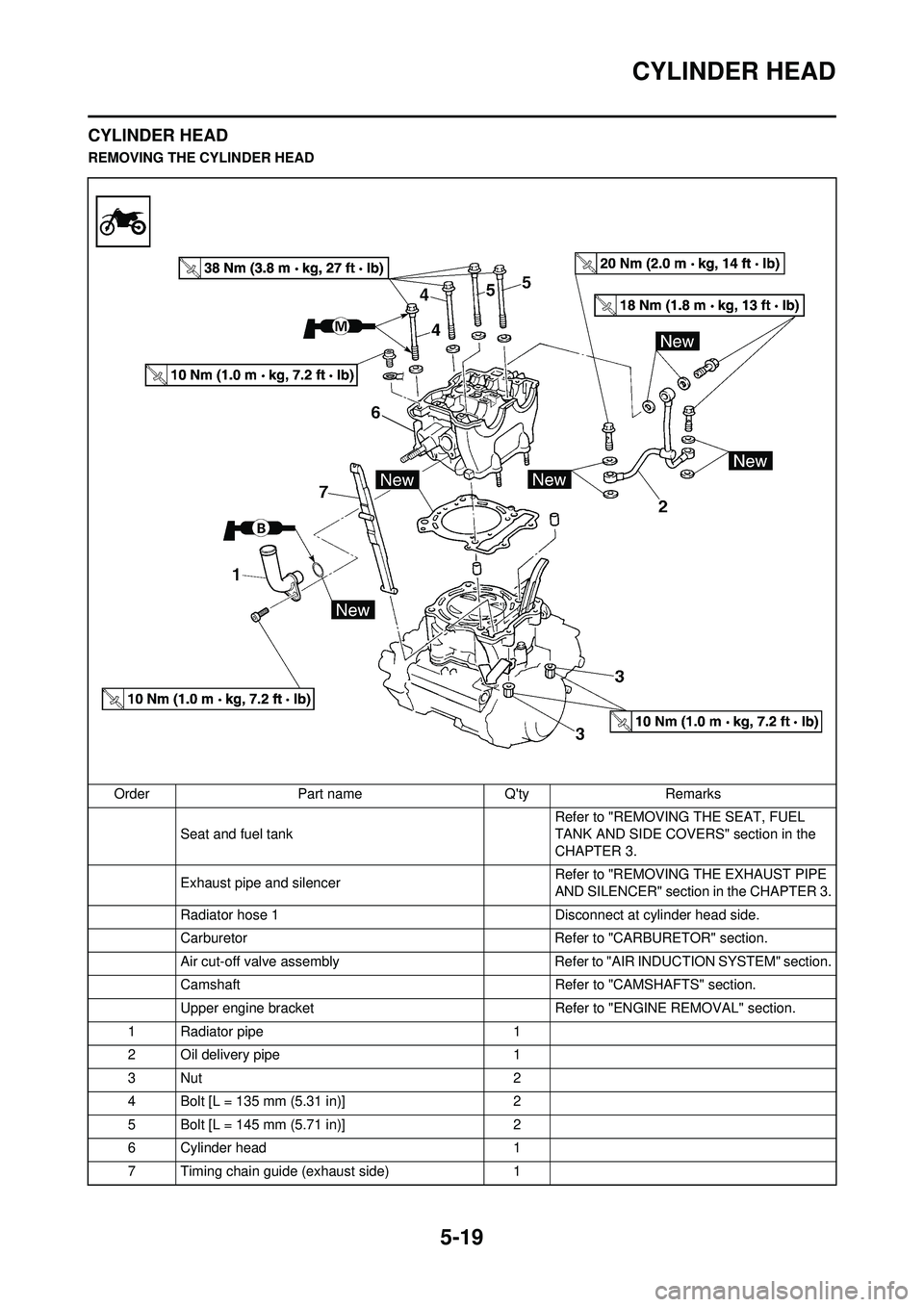
5-19
CYLINDER HEAD
CYLINDER HEAD
REMOVING THE CYLINDER HEADOrder Part name Q'ty Remarks Seat and fuel tank Refer to "REMOVING THE SEAT, FUEL
TANK AND SIDE COVERS" section in the
CHAPTER 3.
Exhaust pipe and silencer Refer to "REMOVING THE EXHAUST PIPE
AND SILENCER" section in the CHAPTER 3.
Radiator hose 1 Disconnect at cylinder head side.
Carburetor Refer to "CARBURETOR" section.
Air cut-off valve assembly Refer to "AIR INDUCTION SYSTEM" section.
Camshaft Refer to "CAMSHAFTS" section.
Upper engine bracket Refer to "ENGINE REMOVAL" section.
1 Radiator pipe 1
2 Oil delivery pipe 1
3Nut 2
4 Bolt [L = 135 mm (5.31 in)] 2
5 Bolt [L = 145 mm (5.71 in)] 2
6 Cylinder head 1
7 Timing chain guide (exhaust side) 1
Page 123 of 232
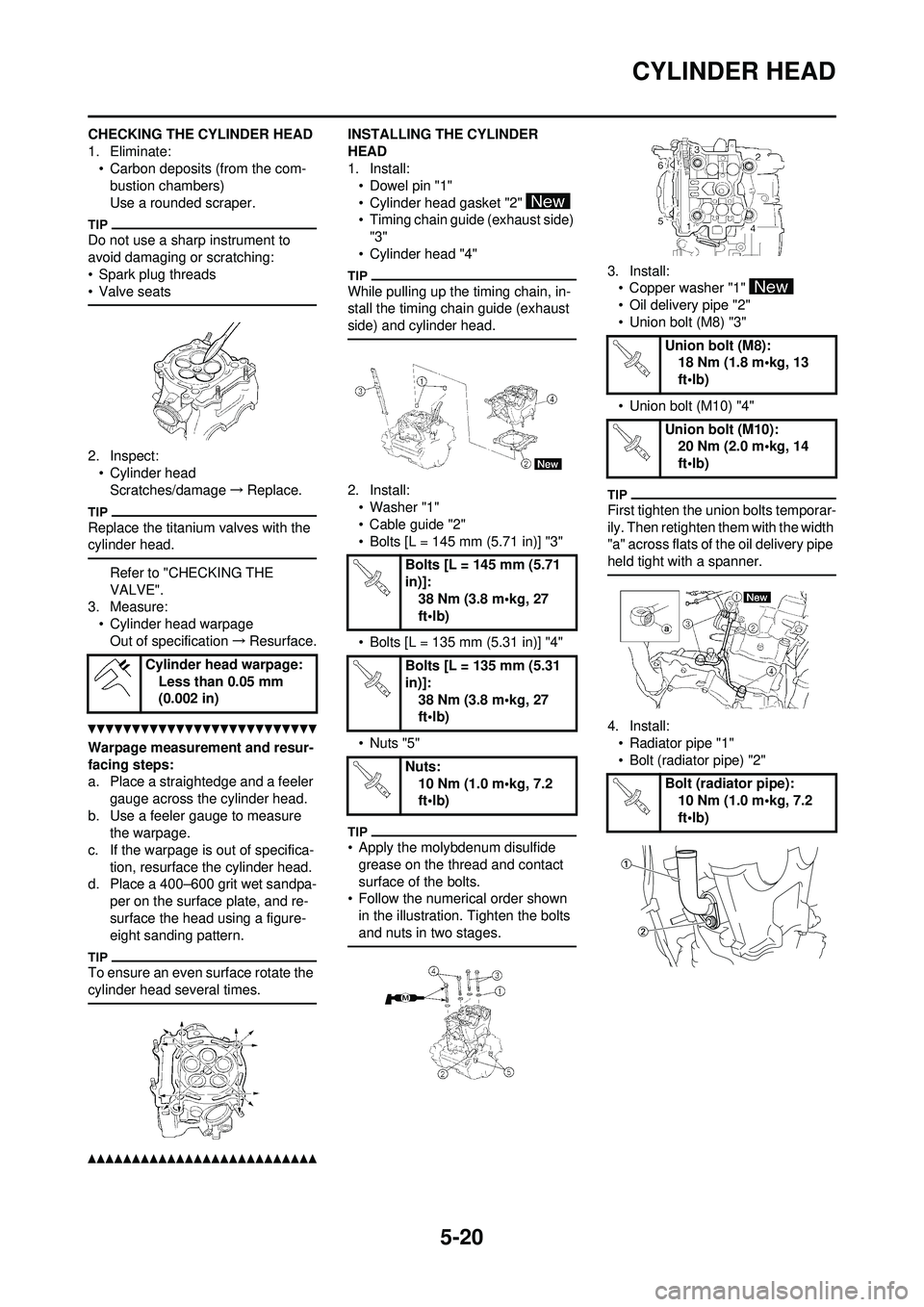
5-20
CYLINDER HEAD
CHECKING THE CYLINDER HEAD
1. Eliminate:• Carbon deposits (from the com-bustion chambers)
Use a rounded scraper.
Do not use a sharp instrument to
avoid damaging or scratching:
• Spark plug threads
• Valve seats
2. Inspect:• Cylinder head
Scratches/damage →Replace.
Replace the titanium valves with the
cylinder head.
Refer to "CHECKING THE
VALVE".
3. Measure:
• Cylinder head warpageOut of specification →Resurface.
Warpage measurement and resur-
facing steps:
a. Place a straightedge and a feeler
gauge across the cylinder head.
b. Use a feeler gauge to measure the warpage.
c. If the warpage is out of specifica- tion, resurface the cylinder head.
d. Place a 400–600 grit wet sandpa-
per on the surface plate, and re-
surface the head using a figure-
eight sanding pattern.
To ensure an even surface rotate the
cylinder head several times.
INSTALLING THE CYLINDER
HEAD
1. Install:• Dowel pin "1"
• Cylinder head gasket "2"
• Timing chain guide (exhaust side) "3"
• Cylinder head "4"
While pulling up the timing chain, in-
stall the timing chain guide (exhaust
side) and cylinder head.
2. Install: • Washer "1"
• Cable guide "2"
• Bolts [L = 145 mm (5.71 in)] "3"
• Bolts [L = 135 mm (5.31 in)] "4"
•Nuts "5"
• Apply the molybdenum disulfide
grease on the thread and contact
surface of the bolts.
• Follow the numerical order shown
in the illustration. Tighten the bolts
and nuts in two stages.
3. Install:• Copper washer "1"
• Oil delivery pipe "2"
• Union bolt (M8) "3"
• Union bolt (M10) "4"
First tighten the union bolts temporar-
ily. Then retighten them with the width
"a" across flats of the oil delivery pipe
held tight with a spanner.
4. Install:
• Radiator pipe "1"
• Bolt (radiator pipe) "2"
Cylinder head warpage:
Less than 0.05 mm
(0.002 in)
Bolts [L = 145 mm (5.71
in)]:38 Nm (3.8 m•kg, 27
ft•lb)
Bolts [L = 135 mm (5.31
in)]: 38 Nm (3.8 m•kg, 27
ft•lb)
Nuts: 10 Nm (1.0 m•kg, 7.2
ft•lb)
Union bolt (M8): 18 Nm (1.8 m•kg, 13
ft•lb)
Union bolt (M10): 20 Nm (2.0 m•kg, 14
ft•lb)
Bolt (radiator pipe): 10 Nm (1.0 m•kg, 7.2
ft•lb)
Page 124 of 232
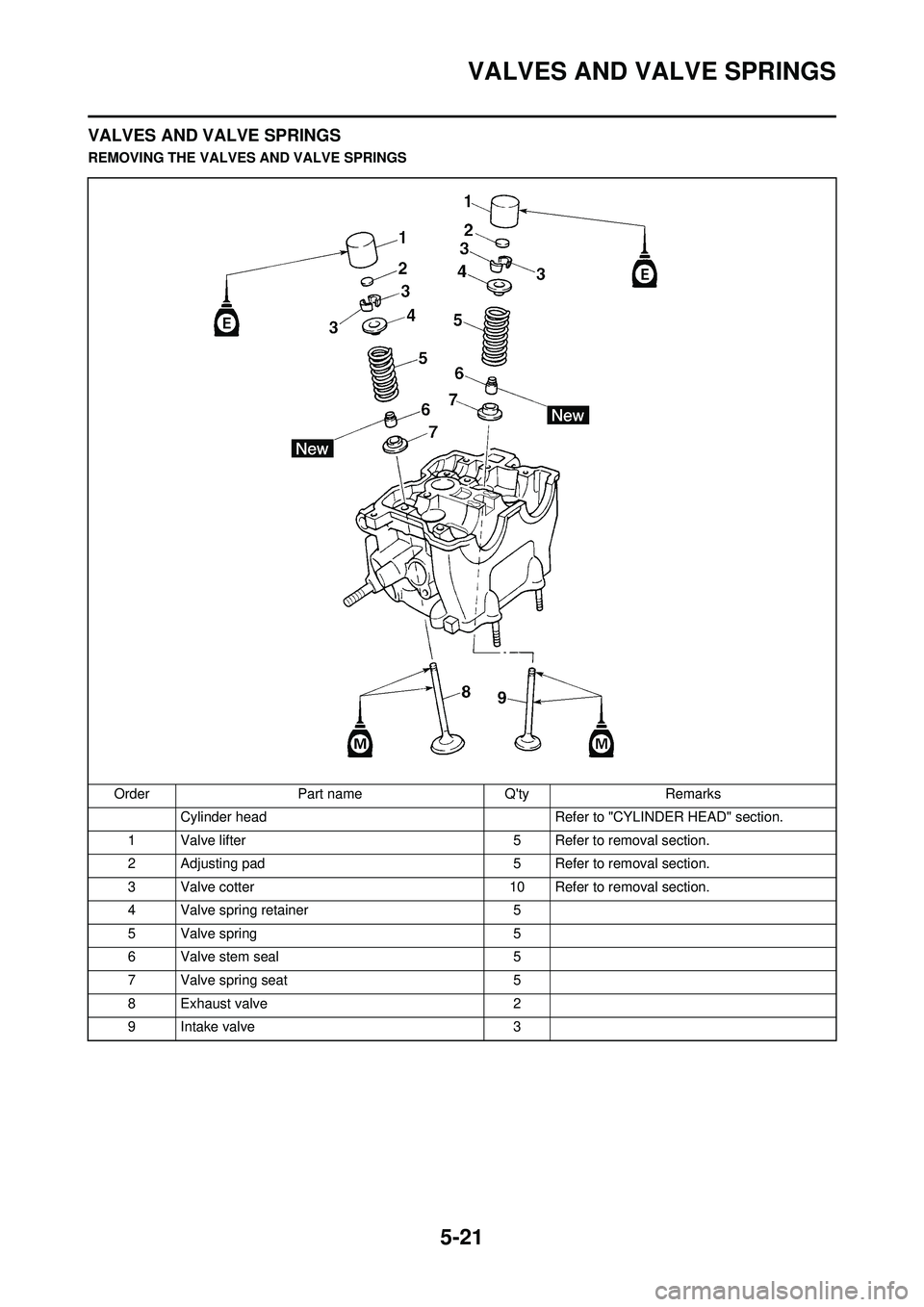
5-21
VALVES AND VALVE SPRINGS
VALVES AND VALVE SPRINGS
REMOVING THE VALVES AND VALVE SPRINGSOrder Part name Q'ty Remarks Cylinder head Refer to "CYLINDER HEAD" section.
1 Valve lifter 5 Refer to removal section.
2 Adjusting pad 5 Refer to removal section.
3 Valve cotter 10 Refer to removal section.
4 Valve spring retainer 5
5 Valve spring 5
6 Valve stem seal 5
7 Valve spring seat 5
8 Exhaust valve 2
9 Intake valve 3
Page 125 of 232
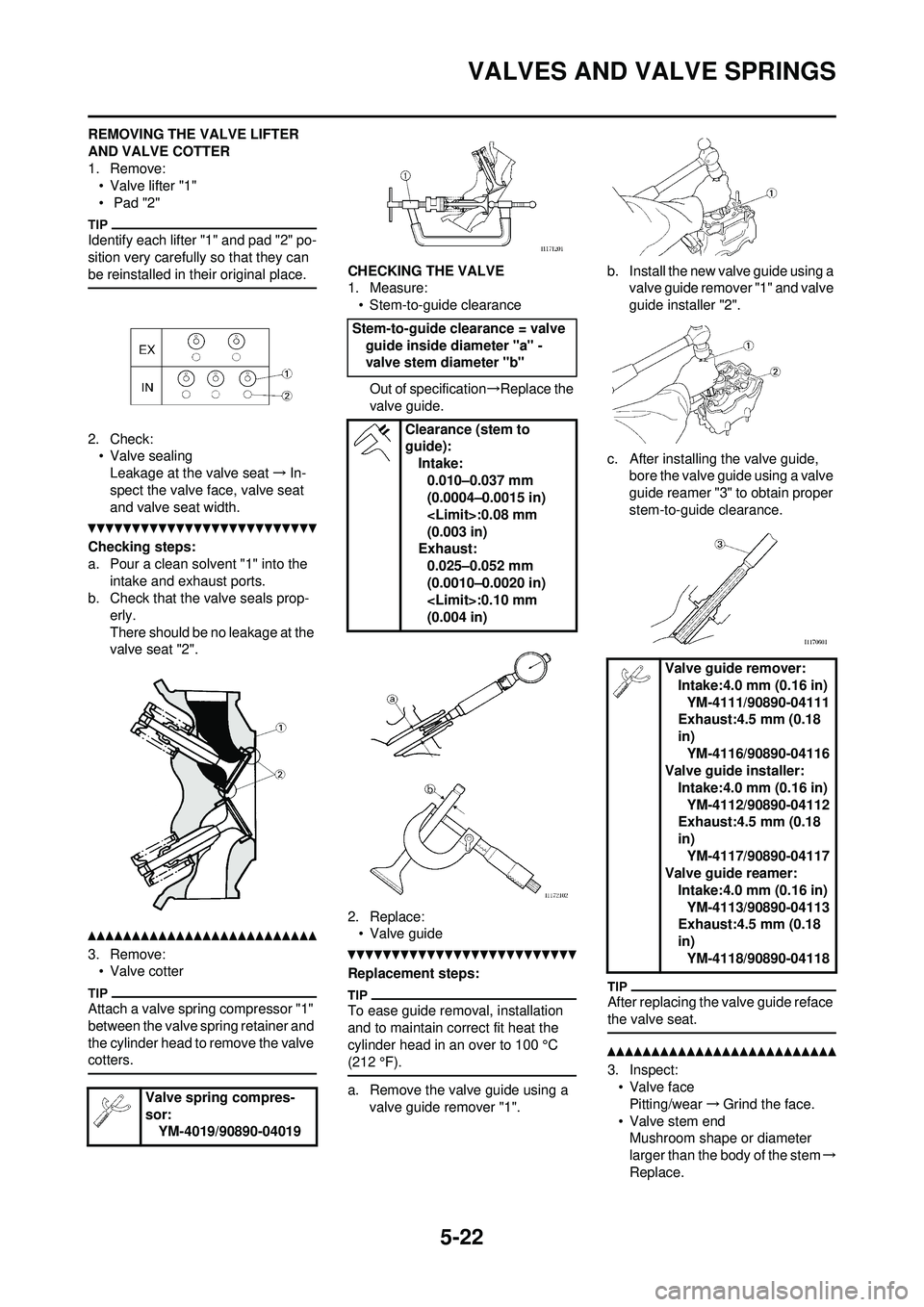
5-22
VALVES AND VALVE SPRINGS
REMOVING THE VALVE LIFTER
AND VALVE COTTER
1. Remove:• Valve lifter "1"
• Pad "2"
Identify each lifter "1" and pad "2" po-
sition very carefully so that they can
be reinstalled in their original place.
2. Check:• Valve sealingLeakage at the valve seat →In-
spect the valve face, valve seat
and valve seat width.
Checking steps:
a. Pour a clean solvent "1" into the intake and exhaust ports.
b. Check that the valve seals prop- erly.
There should be no leakage at the
valve seat "2".
3. Remove:• Valve cotter
Attach a valve spring compressor "1"
between the valve spring retainer and
the cylinder head to remove the valve
cotters.
CHECKING THE VALVE
1. Measure:
• Stem-to-guide clearance
Out of specification →Replace the
valve guide.
2. Replace: • Valve guide
Replacement steps:
To ease guide removal, installation
and to maintain correct fit heat the
cylinder head in an over to 100 °C
(212 °F).
a. Remove the valve guide using a valve guide remover "1". b. Install the new valve guide using a
valve guide remover "1" and valve
guide installer "2".
c. After installing the valve guide, bore the valve guide using a valve
guide reamer "3" to obtain proper
stem-to-guide clearance.
After replacing the valve guide reface
the valve seat.
3. Inspect:• Valve face
Pitting/wear →Grind the face.
• Valve stem end Mushroom shape or diameter
larger than the body of the stem →
Replace.
Valve spring compres-
sor:
YM-4019/90890-04019
Stem-to-guide clearance = valve guide inside diameter "a" -
valve stem diameter "b"
Clearance (stem to
guide):Intake:0.010–0.037 mm
(0.0004–0.0015 in)
(0.003 in)
Exhaust:
0.025–0.052 mm
(0.0010–0.0020 in)
(0.004 in)
Valve guide remover: Intake:4.0 mm (0.16 in)
YM-4111/90890-04111
Exhaust:4.5 mm (0.18
in)
YM-4116/90890-04116
Valve guide installer: Intake:4.0 mm (0.16 in)
YM-4112/90890-04112
Exhaust:4.5 mm (0.18
in)
YM-4117/90890-04117
Valve guide reamer: Intake:4.0 mm (0.16 in)
YM-4113/90890-04113
Exhaust:4.5 mm (0.18
in)
YM-4118/90890-04118
Page 126 of 232
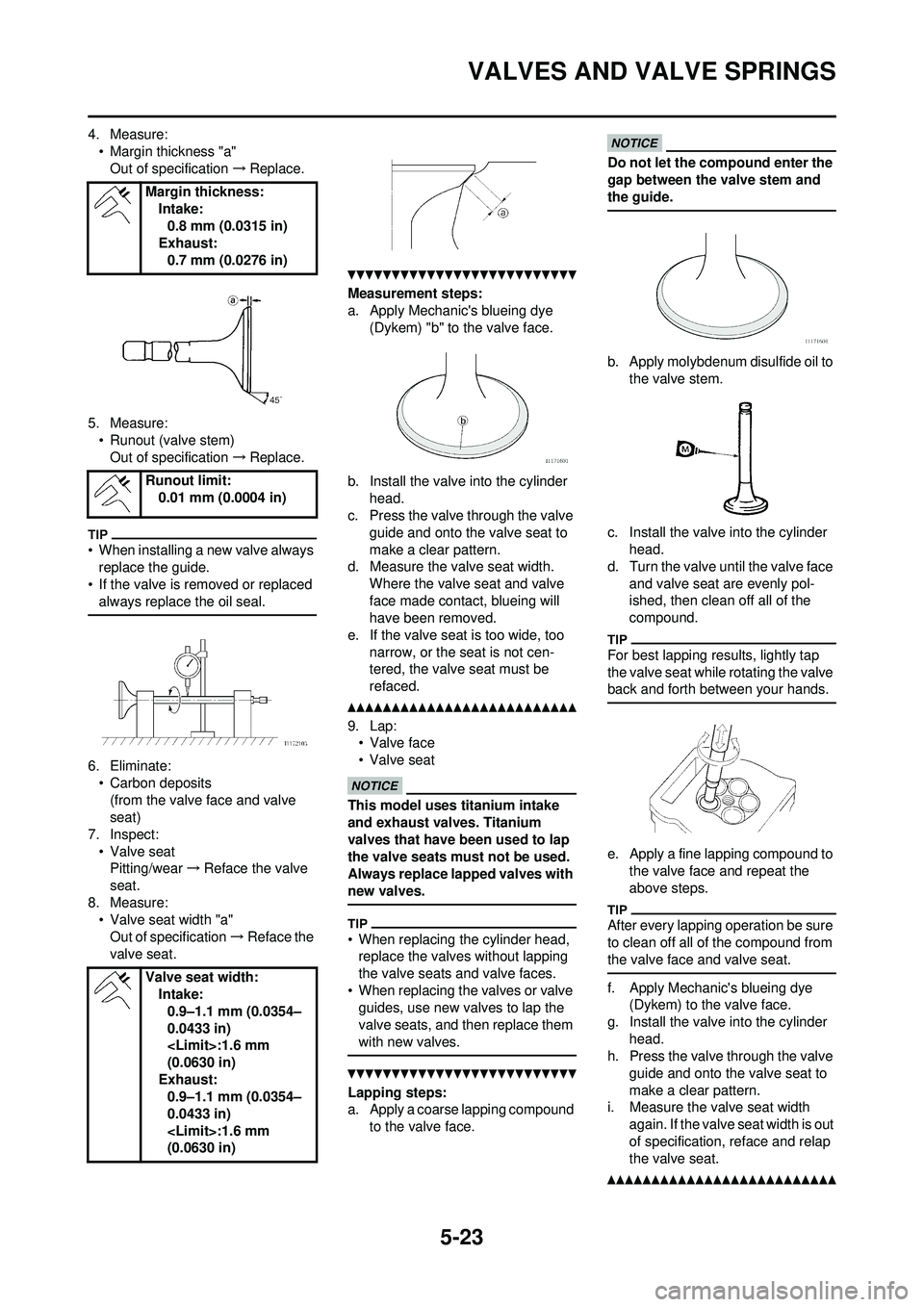
5-23
VALVES AND VALVE SPRINGS
4. Measure:• Margin thickness "a"Out of specification →Replace.
5. Measure: • Runout (valve stem)Out of specification →Replace.
• When installing a new valve always
replace the guide.
• If the valve is removed or replaced
always replace the oil seal.
6. Eliminate:• Carbon deposits(from the valve face and valve
seat)
7. Inspect: • Valve seatPitting/wear →Reface the valve
seat.
8. Measure: • Valve seat width "a"
Out of specification →Reface the
valve seat.
Measurement steps:
a. Apply Mechanic's blueing dye (Dykem) "b" to the valve face.
b. Install the valve into the cylinder head.
c. Press the valve through the valve guide and onto the valve seat to
make a clear pattern.
d. Measure the valve seat width. Where the valve seat and valve
face made contact, blueing will
have been removed.
e. If the valve seat is too wide, too
narrow, or the seat is not cen-
tered, the valve seat must be
refaced.
9. Lap: • Valve face
• Valve seat
This model uses titanium intake
and exhaust valves. Titanium
valves that have been used to lap
the valve seats must not be used.
Always replace lapped valves with
new valves.
• When replacing the cylinder head, replace the valves without lapping
the valve seats and valve faces.
• When replacing the valves or valve guides, use new valves to lap the
valve seats, and then replace them
with new valves.
Lapping steps:
a. Apply a coarse lapping compound
to the valve face.
Do not let the co mpound enter the
gap between the valve stem and
the guide.
b. Apply molybdenum disulfide oil to the valve stem.
c. Install the valve into the cylinder head.
d. Turn the valve until the valve face
and valve seat are evenly pol-
ished, then clean off all of the
compound.
For best lapping results, lightly tap
the valve seat while rotating the valve
back and forth between your hands.
e. Apply a fine lapping compound to the valve face and repeat the
above steps.
After every lapping operation be sure
to clean off all of the compound from
the valve face and valve seat.
f. Apply Mechanic's blueing dye (Dykem) to the valve face.
g. Install the valve into the cylinder
head.
h. Press the valve through the valve guide and onto the valve seat to
make a clear pattern.
i. Measure the valve seat width again. If the valve seat width is out
of specification, reface and relap
the valve seat.
Margin thickness:Intake:
0.8 mm (0.0315 in)
Exhaust: 0.7 mm (0.0276 in)
Runout limit: 0.01 mm (0.0004 in)
Valve seat width: Intake:
0.9–1.1 mm (0.0354–
0.0433 in)
(0.0630 in)
Exhaust: 0.9–1.1 mm (0.0354–
0.0433 in)
(0.0630 in)
Page 127 of 232

5-24
VALVES AND VALVE SPRINGS
CHECKING THE VALVE SPRINGS
1. Measure:• Valve spring free length "a"Out of specification →Replace.
2. Measure: • Compressed spring force "a"Out of specification →Replace.
b. Installed length
3. Measure:
• Spring tilt "a"Out of specification →Replace. CHECKING THE
VALVE LIFTERS
1. Inspect:
• Valve lifterScratches/damage →Replace
both lifters and cylinder head.
INSTALLING THE VALVES
1. Apply: • Molybdenum disulfide oil
Onto the valve stem and valve
stem seal.
2. Install:
• Valve "1"
• Valve spring seat "2"
• Valve stem seal "3"
• Valve spring "4"
• Valve spring retainer "5"To cylinder head.
• Make sure that each valve is in-
stalled in its original place, also re-
ferring to the painted color as
follows.
Intake (middle) "a": Orange
Intake (right/left) "b": Green
Exhaust "c": Purple
• Install the valve springs with the larger pitch "d" facing upward.
e. Smaller pitch 3. Install:
• Valve cotter
While compressing the valve spring
with a valve spring compressor "1" in-
stall the valve cotters.
4. To secure the valve cotters onto the valve stem, lightly tap the
valve tip with a piece of wood.
Hitting the valve tip with excessive
force could damage the valve.
5. Install:• Adjusting pad "1"
• Valve lifter "2"
• Apply the molybdenum disulfide oil on the valve stem end.
• Apply the engine oil on the valve lift-
ers.
• Valve lifter must turn smoothly when rotated with a finger.
• Be careful to reinstall valve lifters and pads in their original place.
Free length (valve
spring): Intake:36.58 mm (1.44 in)
(1.45 in)
Exhaust:
35.58 mm (1.40 in)
(1.44 in)
Compressed spring
force: Intake:103–118 N at 29.13
mm (10.50–12.09 kg at
29.13 mm, 23.15–
26.66 lb at 1.15 in)
Exhaust: 126–144 N at 29.30
mm (12.85–14.68 kg at
29.30 mm, 28.32–
32.37 lb at 1.15 in)
Spring tilt limit: Intake:
2.5°/1.6 mm (0.063 in)
Exhaust: 2.5°/1.6 mm (0.063 in)
Valve spring compres-
sor:
YM-4019/90890-04019
Page 128 of 232
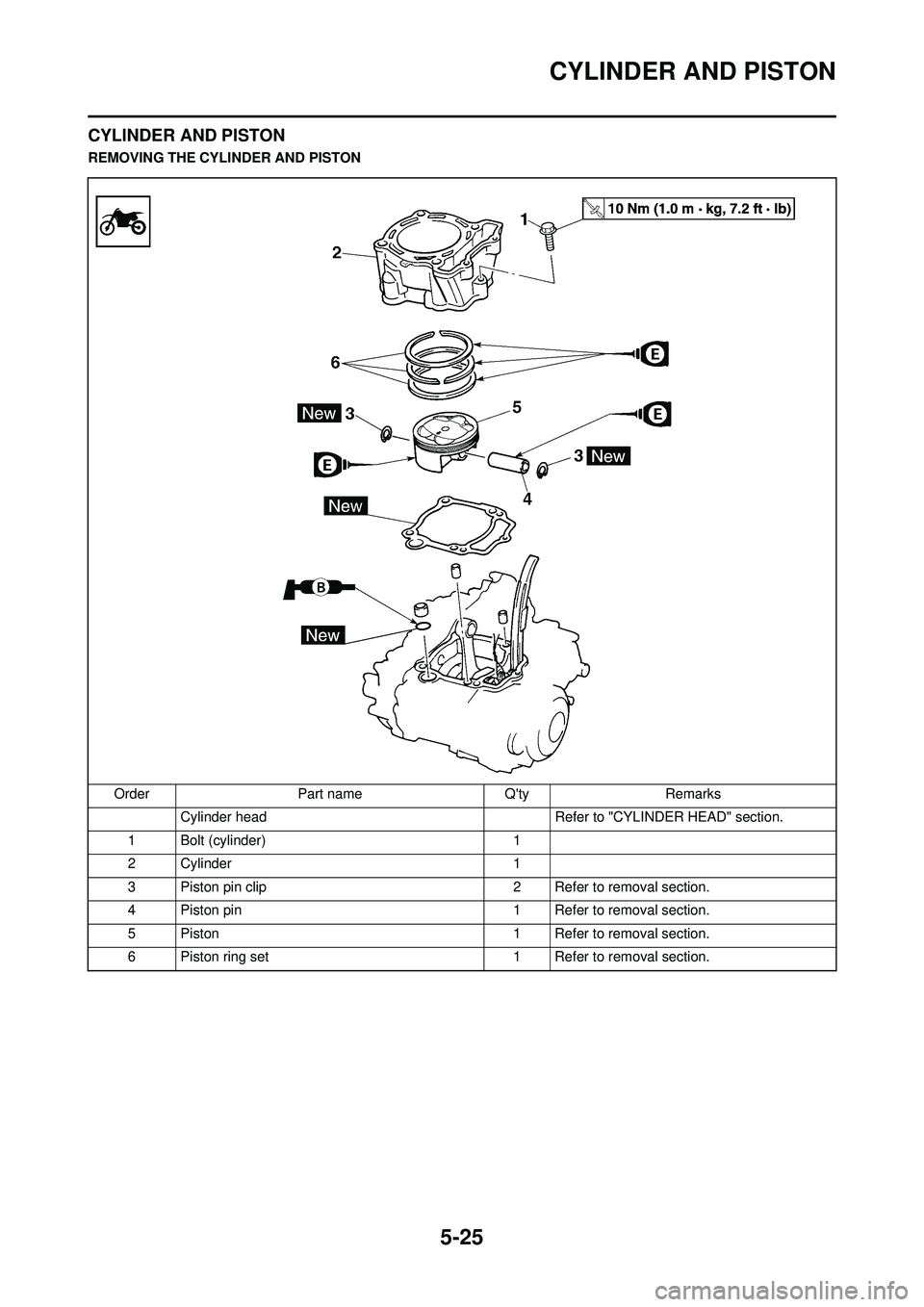
5-25
CYLINDER AND PISTON
CYLINDER AND PISTON
REMOVING THE CYLINDER AND PISTONOrder Part name Q'ty Remarks Cylinder head Refer to "CYLINDER HEAD" section.
1 Bolt (cylinder) 1
2 Cylinder 1
3 Piston pin clip 2 Refer to removal section.
4 Piston pin 1 Refer to removal section.
5 Piston 1 Refer to removal section.
6 Piston ring set 1 Refer to removal section.
Page 129 of 232
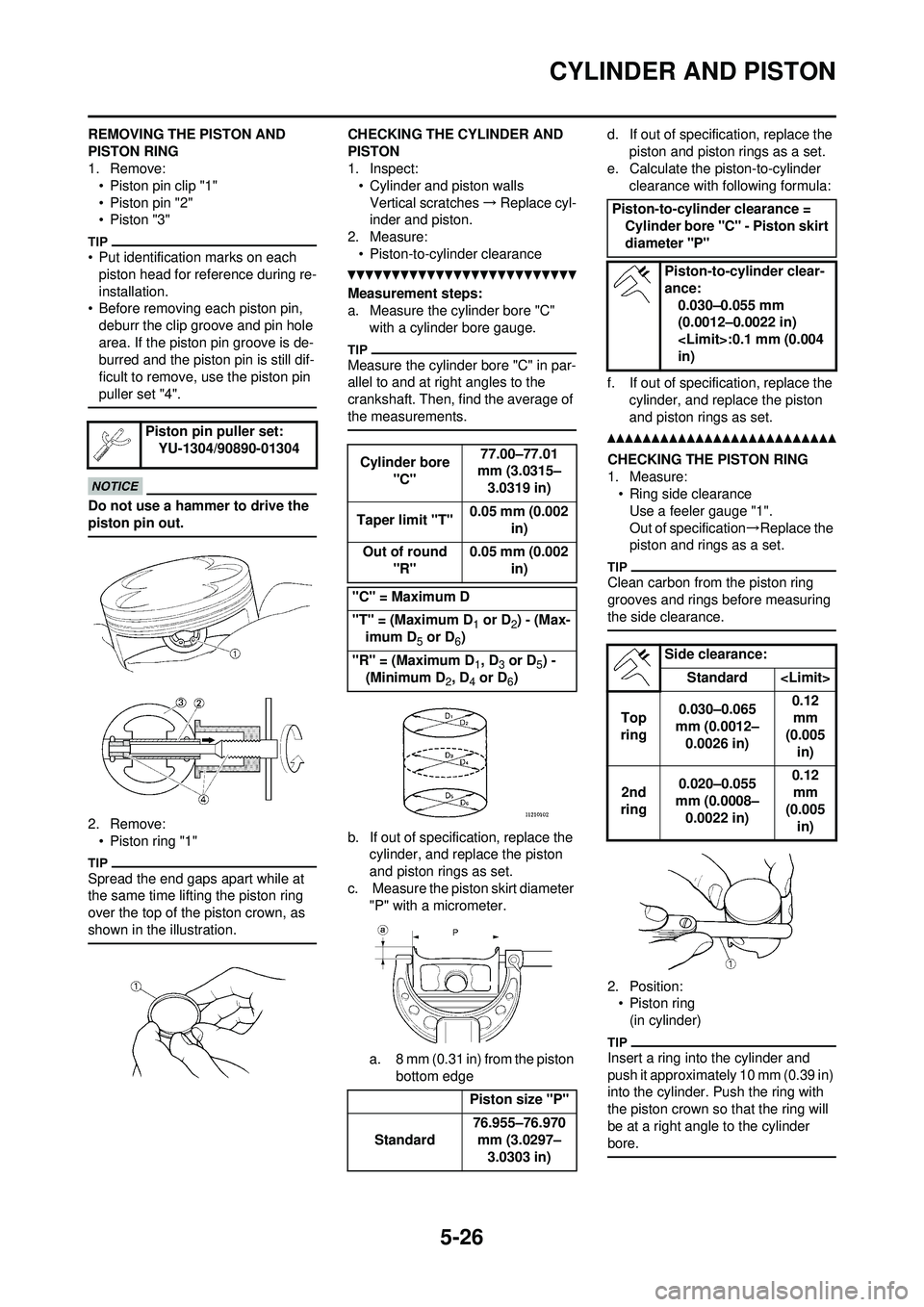
5-26
CYLINDER AND PISTON
REMOVING THE PISTON AND
PISTON RING
1. Remove:• Piston pin clip "1"
• Piston pin "2"
• Piston "3"
• Put identification marks on each piston head for reference during re-
installation.
• Before removing each piston pin, deburr the clip groove and pin hole
area. If the piston pin groove is de-
burred and the piston pin is still dif-
ficult to remove, use the piston pin
puller set "4".
Do not use a hammer to drive the
piston pin out.
2. Remove:
• Piston ring "1"
Spread the end gaps apart while at
the same time lifting the piston ring
over the top of the piston crown, as
shown in the illustration.
CHECKING THE CYLINDER AND
PISTON
1. Inspect:• Cylinder and piston walls
Vertical scratches →Replace cyl-
inder and piston.
2. Measure:
• Piston-to-cylinder clearance
Measurement steps:
a. Measure the cylinder bore "C" with a cylinder bore gauge.
Measure the cylinder bore "C" in par-
allel to and at right angles to the
crankshaft. Then, find the average of
the measurements.
b. If out of specific ation, replace the
cylinder, and replace the piston
and piston rings as set.
c. Measure the piston skirt diameter "P" with a micrometer.
a. 8 mm (0.31 in) from the piston bottom edge d. If out of specification, replace the
piston and piston rings as a set.
e. Calculate the piston-to-cylinder clearance with following formula:
f. If out of specification, replace the cylinder, and replace the piston
and piston rings as set.
CHECKING THE PISTON RING
1. Measure:• Ring side clearance
Use a feeler gauge "1".
Out of specification →Replace the
piston and rings as a set.
Clean carbon from the piston ring
grooves and rings before measuring
the side clearance.
2. Position: • Piston ring(in cylinder)
Insert a ring into the cylinder and
push it approximately 10 mm (0.39 in)
into the cylinder. Push the ring with
the piston crown so that the ring will
be at a right angle to the cylinder
bore.
Piston pin puller set:
YU-1304/90890-01304
Cylinder bore "C" 77.00–77.01
mm (3.0315– 3.0319 in)
Taper limit "T" 0.05 mm (0.002
in)
Out of round "R" 0.05 mm (0.002
in)
"C" = Maximum D
"T" = (Maximum D
1 or D2) - (Max-
imum D
5 or D6)
"R" = (Maximum D
1, D3 or D5) -
(Minimum D
2, D4 or D6)
Piston size "P"
Standard 76.955–76.970
mm (3.0297– 3.0303 in)
Piston-to-cylinder clearance =
Cylinder bore "C" - Piston skirt
diameter "P"
Piston-to-cylinder clear-
ance:0.030–0.055 mm
(0.0012–0.0022 in)
in)
Side clearance: Standard
Top
ring 0.030–0.065
mm (0.0012– 0.0026 in) 0.12
mm
(0.005 in)
2nd
ring 0.020–0.055
mm (0.0008– 0.0022 in) 0.12
mm
(0.005 in)
Page 130 of 232
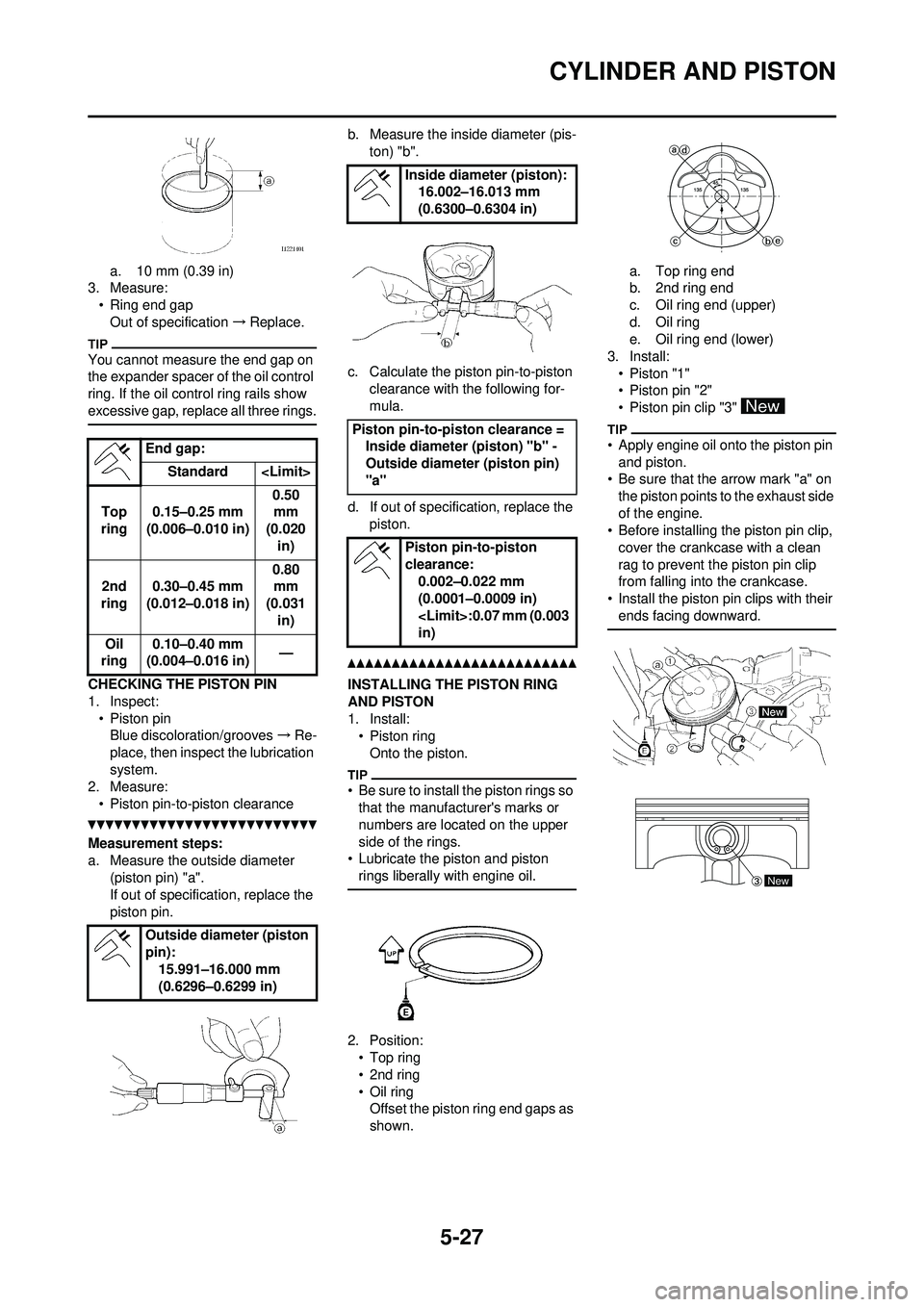
5-27
CYLINDER AND PISTON
a. 10 mm (0.39 in)
3. Measure:
• Ring end gapOut of specification →Replace.
You cannot measure the end gap on
the expander spacer of the oil control
ring. If the oil control ring rails show
excessive gap, replace all three rings.
CHECKING THE PISTON PIN
1. Inspect:
• Piston pinBlue discoloration/grooves →Re-
place, then inspect the lubrication
system.
2. Measure:
• Piston pin-to-piston clearance
Measurement steps:
a. Measure the outside diameter (piston pin) "a".
If out of specification, replace the
piston pin. b. Measure the inside diameter (pis-
ton) "b".
c. Calculate the piston pin-to-piston clearance with the following for-
mula.
d. If out of specific ation, replace the
piston.
INSTALLING THE PISTON RING
AND PISTON
1. Install: •Piston ringOnto the piston.
• Be sure to install the piston rings so that the manufacturer's marks or
numbers are located on the upper
side of the rings.
• Lubricate the piston and piston
rings liberally with engine oil.
2. Position:•Top ring
• 2nd ring
• Oil ringOffset the piston ring end gaps as
shown. a. Top ring end
b. 2nd ring end
c. Oil ring end (upper)
d. Oil ring
e. Oil ring end (lower)
3. Install: • Piston "1"
• Piston pin "2"
• Piston pin clip "3"
• Apply engine oil onto the piston pin and piston.
• Be sure that the arrow mark "a" on
the piston points to the exhaust side
of the engine.
• Before installing the piston pin clip,
cover the crankcase with a clean
rag to prevent the piston pin clip
from falling into the crankcase.
• Install the piston pin clips with their ends facing downward.End gap:
Standard
Top
ring 0.15–0.25 mm
(0.006–0.010 in) 0.50
mm
(0.020
in)
2nd
ring 0.30–0.45 mm
(0.012–0.018 in) 0.80
mm
(0.031
in)
Oil
ring 0.10–0.40 mm
(0.004–0.016 in) —
Outside diameter (piston
pin): 15.991–16.000 mm
(0.6296–0.6299 in)
Inside diameter (piston):16.002–16.013 mm
(0.6300–0.6304 in)
Piston pin-to-pis ton clearance =
Inside diameter (piston) "b" -
Outside diameter (piston pin)
"a"
Piston pin-to-piston
clearance:0.002–0.022 mm
(0.0001–0.0009 in)
in)
New